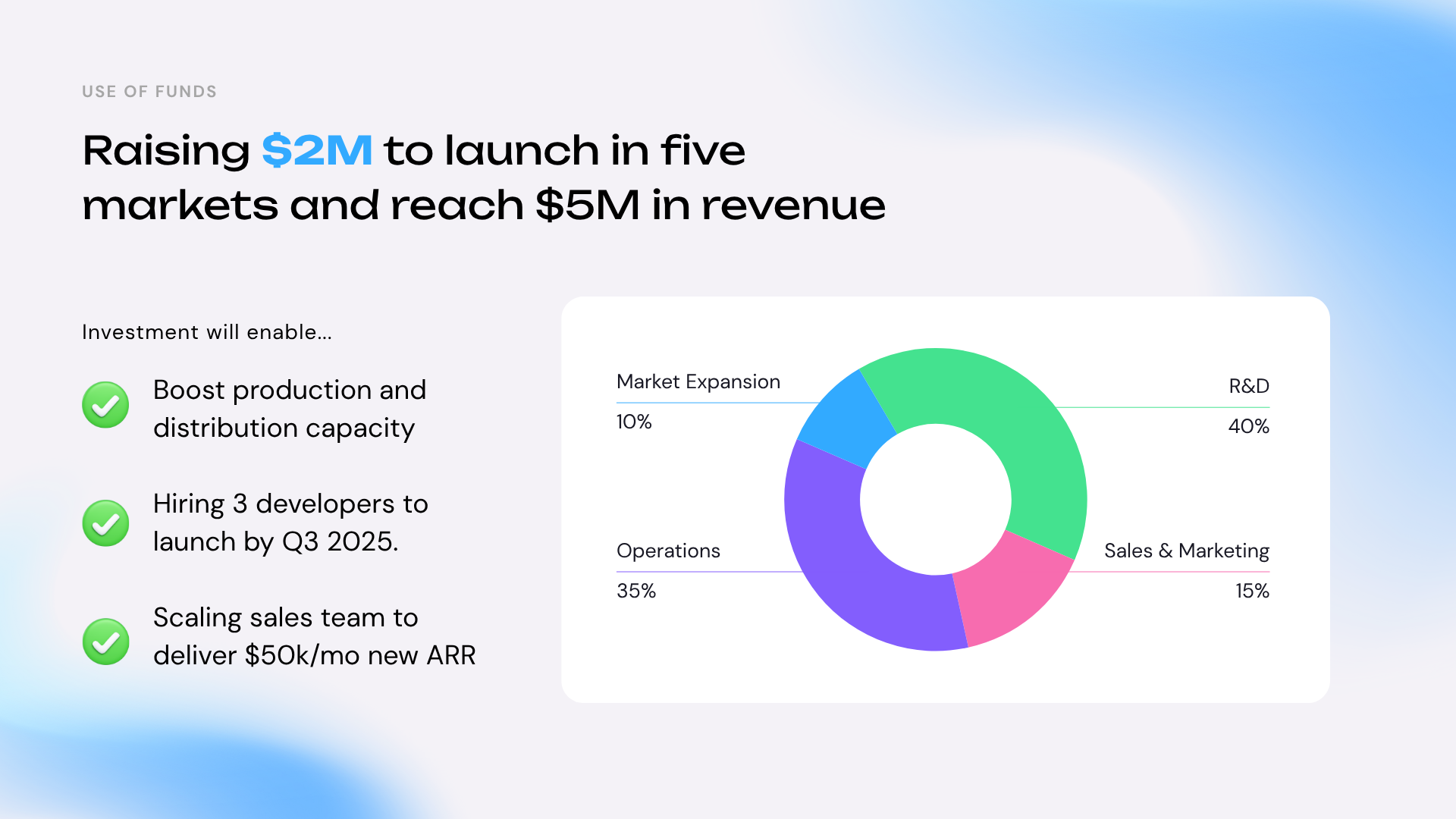A simple mistake that costs millions: Use of Funds are missing in 56% of startup pitch decks.
Publicly-available pitch decks often omit the ‘Use of Funds’ slide to protect company data. But it shouldn’t be an afterthought. For 56% of startup decks, this slide is weak or missing altogether. In 2025’s highly selective funding landscape, that oversight can be the dealbreaker.
Today’s investors expect more than flashy vision and upward-trending graphs. With US VC deals hitting record highs in dollar terms but falling in number—$91.5 billion invested in Q1 2025 across fewer deals than in prior years—the bar for diligence, transparency, and capital efficiency is sky-high. VCs saw too many investment dollars wasted during the easy-money era of 2021. Now, larger checks mean higher accountability: your “Use of Funds” is not just a financial breakdown, it’s a direct reflection of your judgment and scalability.
Why the Use of Funds Slide Matters in 2025
A detailed “Use of Funds” slide is a startup’s chance to demonstrate stewardship: the ability to do a lot with a little. Investors are not impressed by generic, catch-all categories or round numbers that feel plucked from the air. Instead, they’re scrutinizing how you’ll allocate hard-won capital—looking for signals that your executive team can prioritize, plan for milestones, and maximize returns.
What do bad or missing Use of Funds slides signal to VCs?
- Ambiguity: Are founders hiding a lack of strategy? If you can’t show what you’ll do with the next $2 million, how will you allocate $20 million down the line?
- Wishful thinking: Listings like “Marketing, Product, Ops” with no detail signal a lack of operational rigor.
- Red flags for waste: Overly generous founder salaries, vague “R&D”, or a perfect 33/33/33 split across categories raise questions about financial discipline.
- Lost opportunity: Slides that don’t tie spend to measurable outcomes leave investors guessing how their dollars translate into growth or de-risking milestones.
In a market where the median Series A company now needs $2.5M in annual revenue (up 75% since 2021) just to get a look, every line item on your “Use of Funds” slide is under the microscope. A compelling, milestone-driven slide proves you have a plan, not just a wish list.

What Investors Expect
In 2025, top investors and CVCs want to see:
- Specific allocation by function: Break down funding across R&D, product, team expansion, sales/marketing, regulatory, and runway. Pie or bar charts work best.
- Milestone-driven expense planning: Don’t just state categories—tie each line to what it actually enables. For example: “$500K to launch v2.0 platform and win 100 pilot users.”
- Visual clarity: Organize spend around your unique growth narrative. If you’re scaling internationally, show how much is geared specifically toward market entry versus product refinement.
- Transparency about timing: Some founders layer in a timeline (e.g., how funds deploy over 18 months)—especially powerful for Series A or B rounds.
As more corporate VCs and late-stage funds dominate the capital flow (ten mega-deals already account for >60% of US VC investment in 20252), funders demand the rigor—and reporting clarity—they’re accustomed to from public markets.
How to Craft a High-Impact ‘Use of Funds’ Slide (Step by Step)
A winning “Use of Funds” slide doesn’t just tally dollars—it tells a story.
1. Start with Your Total Raise.E.g.: “We’re seeking $3M in this round.”
2. Break Down by Major Categories.List as percentages and dollar values (e.g., “Product Development: 40% / $1.2M”). Typical categories:
- Product/R&D
- Team hires
- Go-to-Market/Sales
- Marketing
- Regulatory/Compliance
- Operational Runway
3. Define Precise Milestones for Each Segment.Example: “$800K to hire 3 senior engineers and ship MVP within 6 months; $600K for GTM team to unlock 200 B2B sales leads in 12 months.”
4. Optional: Add a Timeline Overlay.Show how deployment spans over time and aligns with expected growth or product deadlines.
Red flags to avoid:
- Equal “33/33/33” splits (signal lack of planning)
- Unexplained founder compensation
- No linkage between spend and tangible milestones
Anatomy of a winning Use of Funds slide

- Percentage breakdown of where the funding will go.
- Total amount to be raised clearly indicated in the headline
- Clear description of what the startup will achieve with the funding
Industry Nuance
Use of Funds must reflect sector realities:
- AI & Deep Tech: Higher share for top-tier technical hires, compute resources, or cloud credits; explain why talent and infrastructure drives moat or speed to market.
- Biotech: Big allocations for trials, regulatory, clinical validation—timing and tranche planning critical.
- Fintech: Spend on compliance, licensing, and integrations alongside customer acquisition.
- Consumer: Heavier marketing and influencer budget, demand testing, and possibly retail or D2C logistics.
Show you understand the norms and explain any deviations.
In today’s venture market, clarity is your edge.
A tight, strategic “Use of Funds” slide doesn’t just check a box—it directly reassures investors your team is disciplined, metrics-driven, and worthy of a big check in this scrutinized, opportunity-rich fundraising climate.
References:
- TechCrunch: Fix your pitch deck
- GlobalData: US VC funding 2025
- Insights4VC: Q1-2025 VC report
- GoElastic: Venture capital market trends













